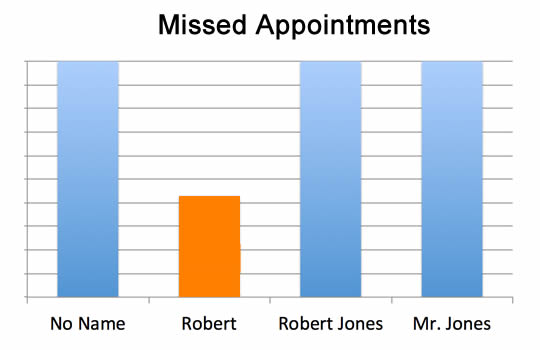Revealed: The Best Way to Personalize
What tiny change to a text message appointment reminder cut no-shows by 57%? All it took was adding the recipient’s first name.
This remarkable result hasn’t been formally published, but is recounted in The Small BIG, the latest effort from Robert Cialdini, Steve Martin, and Noah Goldstein. The study involved medical appointments, an area in which no-shows can in aggregate cost hundreds of millions of dollars annually. (Presumably, in some cases a missed appointment might have serious implications for the patient’s health, too.)
As if cutting no-shows my more than half by a simple change isn’t surprising enough, the researchers also found that other forms of personalization were completely ineffective.

Neither using the patient’s full name (“Robert Jones”) nor a more formal approach (“Mr. Jones”) had any effect on the no-shows.
Another experiment described by the authors showed the first name technique worked for collections, too. Adding the recipient’s first name to a text message boosted the response rate from 23 percent to 33 percent, an increase of 43%.

Every situation is different, of course, and you can’t assume that simply adding a first name to your SMS or email communication will have an enormous impact on response rates. But, these studies definitely suggest using the first name of the recipient should be one of your first tests.
List Building
If you are building a mailing list or generating leads for your business, one of the dilemmas you face is how much information to ask for. As a general rule, every form field you add will reduce the conversion rate. So, many web site operators will take the “single field” approach and just ask for the email address.
While capturing only the visitor’s email will almost certainly maximize the conversion rate, the research suggests that your list will respond significantly better if you are able to use the recipient’s first name.
When I started collecting subscriptions here at Neuromarketing, I started off with an “email only” approach. Later, long before I saw this research, I switched to asking for the first name as well. While my thought at the time was just to form a more personal connection with my readers, after seeing this data I’m glad I made the change.
For more on list-building, see How Top Conversion Experts Seduce You Into Giving Up Your Email.
Are you getting the free Neuromarketing newsletter with great science-backed marketing insights like this one? If not, don’t miss out – take a moment to use the little form below and be sure to include (of course!) your first name!
